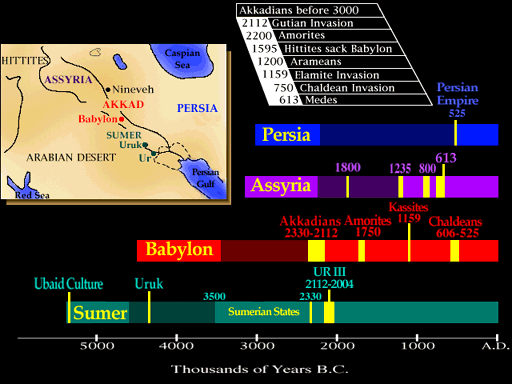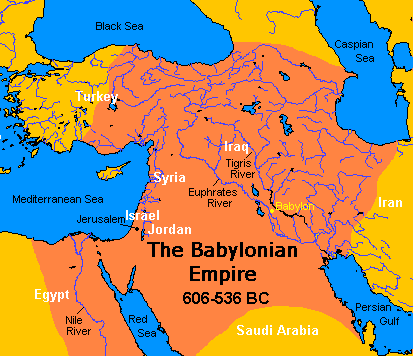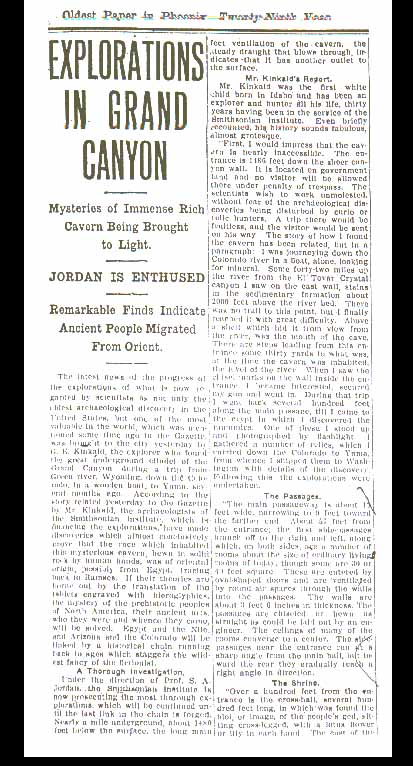


Babylon is the Greek variant of Akkadian Babilu, an ancient city in Mesopotamia. It was the "holy city" of Babylonia from early times, and the seat of the Neo-Babylonian empire from 612 BC. In the Hebrew Bible, the name appears as (Babel), interpreted by popular etymology to mean "confusion". Akkadian bab-ilus means "Gate of God", translating Sumerian Kadingirra. One of the Seven Wonders of the Ancient World, the Hanging Gardens of Babylon, was there.
History
The earliest mention of Babylon is in a dated tablet of the reign of Sargon of Akkad (24th century BC short chr.), who made it the capital of his empire. Over the years its power and population waned. From around the 20th century BC, it was occupied by Amorites (nomadic Semitic tribes), flooding southern Mesopotamia from the the west, until it became the capital of Hammurabi's empire (ca. 18th century BC). From that time onward, it continued to be the capital of Babylonia, though during the 440 years of domination by the Kassites (1595-1155 BC), the city was renamed "Karanduniash".
The city itself was built upon the Euphrates, and divided in equal parts along its left and right banks with steep embankments to contain the river's seasonal floods. Babylon grew in extent and grandeur over time, but gradually became subject to the rule of Assyria.
Assyrian Period
During the reign of Sennacherib of Assyria, Babylonia was in a constant state of revolt, led by Mushezib-Marduk, and suppressed only by the complete destruction of the city of Babylon.
In 689 BC, its walls, temples and palaces were razed to the ground, and the rubbish thrown into the Arakhtu, the canal bordering the earlier Babylon on the south. This act shocked the religious conscience of Mesopotamia; the subsequent murder of Sennacherib was held to be in expiation of it, and his successor Esarhaddon hastened to rebuild the old city, to receive there his crown, and make it his residence during part of the year. On his death, Babylonia was left to his elder son Shamash-shum-ukin, who eventually headed a revolt against his brother Assurbanipal.
Once again, Babylon was besieged by the Assyrians and starved into surrender. Assurbanipal purified the city and celebrated a "service of reconciliation", but did not venture to "take the hands" of Bel. In the subsequent overthrow of the Assyrian empire, the Babylonians saw another example of divine vengeance.
On the fall of Nineveh (612 BC), Babylon threw off the Assyrian yoke, and became the capital of the Neo-Babylonian empire. Egypt had had a very large cultural influence prior to this, until the Babylonians defeated the Egyptians at the Battle of Carchemish and thus removed them as a major world empire.
With the recovery of Babylonian independence under Nabopolassar a new era of architectural activity ensued, and his son Nebuchadrezzar II made Babylon into one of the wonders of the ancient world.
Beautification of Babylon by Nebuchadrezzar II
It was under the rule of king Nebuchadrezzar II (605 BC-562 BC) that Babylon became one of the most splendid cities of the ancient world. Nebuchadrezzar ordered the complete reconstruction of the imperial grounds, including rebuilding the Etemenanki ziggurat and the construction of the Ishtar Gate -- the most spectacular of eight gates that ringed the perimeter of Babylon. The Ishtar Gate survives today in the Pergamon Museum in Berlin. Nebuchadrezzar is also credited with the construction of the Hanging Gardens of Babylon (one of the seven wonders of the ancient world), said to have been built for his homesick wife Amyitis. Whether the gardens did exist is a matter of dispute. Although excavations by German archaeologist Robert Koldewey are thought to reveal its foundations, many historians disagree about the location, and some believe it may have been confused with gardens in Nineveh.
Babylon under the Persians
After passing through various vicissitudes, the city was occupied in 538 BC by Cyrus the Great, king of Persia, who issued a decree permitting the Jews to return to their own land (Ezra 1). Under Cyrus and his heir Darius I, Babylon became a center of learning and scientific advancement. Babylonian scholars completed maps of constellations, and created the foundations of modern astronomy and mathematics. However, during the reign of Darius III, Babylon began to stagnate and degenerate.
Hellenic period
In 331 BC, Darius III was defeated by the forces of the Macedonian ruler Alexander the Great at the battle of Gaugamela, and in October, Babylon saw its own invasion and occupation. A native account of this invasion notes a ruling by Alexander not to enter the homes of its inhabitants.
Under Alexander, Babylon again flourished as a center of learning and commerce. But following Alexander's mysterious death in 323 BC in the palace of Nebuchadrezzar, his empire was divided amongst his generals, and decades of fighting soon began, with Babylon once again caught in the middle.The constant turmoil virtually emptied the city of Babylon. A tablet dated 275 BC states that the inhabitants of Babylon were transported to Seleucia, where a palace was built, as well as a temple given the ancient name of E-Saggila. With this deportation, the history of Babylon comes practically to an end, though more than a century later, it was found that sacrifices were still performed in its old sanctuary. By 141 BC, when the Parthian Empire took over the region, Babylon was in complete desolation and obscurity.
Archaeology of Babylon
Historical knowledge of Babylon's topography is derived from classical writers, the inscriptions of Nebuchadrezzar, and several excavations, including those of the Deutsche Orientgesellschaft begun in 1899. The layout is that of the Babylon of Nebuchadrezzar; the older Babylon destroyed by Sennacherib having left few, if any, traces behind.
Most of the existing remains lie on the east bank of the Euphrates, the principal ones being three vast mounds: the Babil to the north, the Qasr or "Palace" (also known as the Mujelliba) in the centre, and the Ishgn "Amran ibn" All, with the outlying spur of the Jumjuma, to the south. East of these come the Ishgn el-Aswad or "Black Mound" and three lines of rampart, one of which encloses the Babil mound on the N. and E. sides, while a third forms a triangle with the S.E. angle of the other two. West of the Euphrates are other ramparts, and the remains of the ancient Borsippa.
Saddam Hussein installed a huge portrait of himself and Nebuchadrezzar at the entrance to the ruins. He also had part of the ruins rebuilt, to the dismay of archaeologists, with his name inscribed on many of the bricks, in imitation of Nebuchadrezzar. One frequent inscription reads: "This was built by Saddam Hussein, son of Nebuchadnezzar, to glorify Iraq".
This recalls the ziggurat at Ur, where each individual brick was stamped with "Ur-Nammu, king of Ur, who built the temple of Nanna". These bricks became sought after as collectors' items after the downfall of Saddam, and the ruins are no longer being restored to their original state.

Replies
Love!